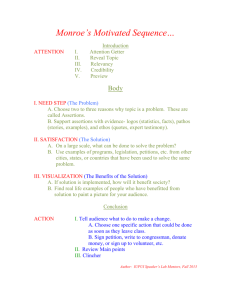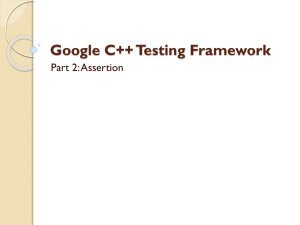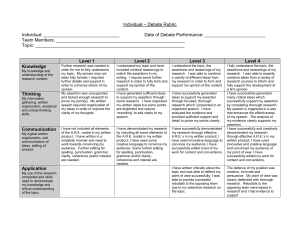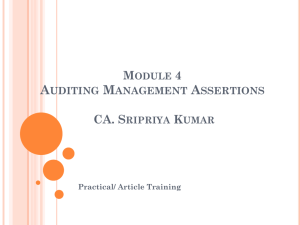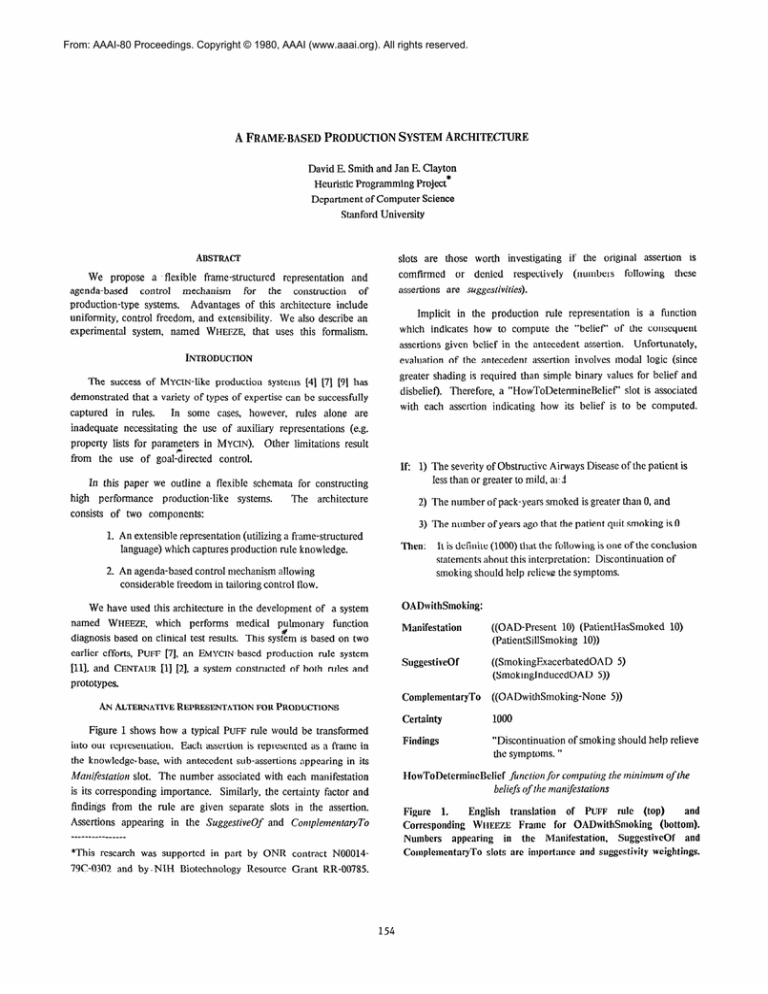
From: AAAI-80 Proceedings. Copyright © 1980, AAAI (www.aaai.org). All rights reserved.
A FRAME-BASEDPRODUCTION SYSTEM ARCHITECTURE
David E. Smith and Jan E. Clayton
Heuristic Programming Project*
Department of Computer Science
Stanford University
ABSTRACT
slots are those worth investigating if the original assertion is
cornfirmed or denied respectively (numbers following these
We propose a flexible frame-structured representation and
agenda-based
control mechanism
for the construction
of
production-type systems. Advantages of this architecture include
uniformity, control freedom, and extensibility. We also describe an
experimental system, named WHJXZE, that uses this formalism.
assertions are suggesfivilies).
Implicit in the production
rule representation
is a fimction
which indicates how to compute the “belief’ of the consequent
assertions given belief in the antecedent assertion. Unfortunately,
evaluation of the antecedent assertion involves modal logic (since
greater shading is required than simple binary values for belief and
disbelief). Therefore, a “HowToDetermineBelief’ slot is associated
The success of MYCIN-like production systems 141 [7] [9] has
demonstrated that a variety of types of expertise can be successfully
captured in rules.
In some cases, however, rules alone are
inadequate necessitating the USC of auxiliary representations (e.g.
property lists for paramzters in MYCIN). Other limitations result
from the use of goal-directed
with each assertion indicating how its belief is to be computed.
control.
If: 1) The severity of Obstructive Airways Disease of the patient is
less than or greater to mild, al’;1
In this paper we outline a flexible schemata for constructing
performance production-like systems.
The architecture
consists of two components:
high
2) The number of pack-years smoked is greater than 0, and
3) The number of years ago that the patient quit smoking is 0
1. An extensible representation (utilizing a frame-structured
language) which captures production rule knowledge.
Then:
2. An agenda-based control mechanism allowing
considerable freedom in tailoring control flow.
It is definite (1000) that the following is one of the conclusion
statements about this interpretation: Discontinuation of
smoking should help re1iev.ethe symptoms.
OADwithSmoking:
We have used this architecture in the development of a system
named WHEEZE, which performs medical pulmonary function
diagnosis based on clinical test results. This syst%m is based on two
earlier efforts, PUFF [7], an EMYCIN-based production rule system
Ill], and CENTAUR[l] 121,a system constructed of both rules and
prototypes.
Manifestation
((OAD-Present 10) (PatientHasSmoked
(PatientSillSmoking 10))
10)
SuggestiveOf
((SmokingExaccrbatedOAD 5)
(SmokingInduccdOAD 5))
ComplementaryTo
((OADwithSmoking-None
Certainty
1000
Findings
“Discontinuation of smoking should help relieve
the symptoms. ”
5))
AN ~LTERNATXVE
RI~PRESENTATION
FOHPRODUCTIONS
Figure 1 shows how a typical PUFF rule would be transformed
into our representation. Each assertion is represented as a frame in
the knowledge. base, with anteccdcnt sub-assertions appearing in its
HowToDetermincBelicf finelion for compuring the minimum of the
h4auzjdarion
slot. The number associated with each manifestation
is its corresponding importance. Similarly, the certainty factor and
findings from the rule are given separate slots in the assertion.
Assertions appearing in the SuggesliveOf and ComplemenlaryTo
beliefs of the manifestations
and
Figure 1. English translation of PUFF rule (top)
Corresponding WHEEZE Frame for OADwithSmoking (bottom).
Numbers appearing in the Manifestation, SuggcstiveOf and
Complcmcntaryl’o slots arc importance and suggcstivity wcightings.
. . ..-...........
*This research was supported in part by ONR contract N0001479C-0302 and by .NIH Biotechnology Resource Grant RR-00785.
54
The
declarative
nature
of
this
representation
By varying the importance factors, SuggesfiveOf
facilitates
values, and the
knowledge, such as justifications, explanations, and instructional
initial items placed on the agenda, numerous strategies are possible.
For example, if high-level goals are initially placed on the agenda
material, can be accomplished by the addition of slots to already
existing assertions. The single uniform structure alleviates the need
and subgoals are always placed at the top of the agenda, depth-first
goal-directed behavior will result. Alternatively, if low-level data
modification and extension.
For example, the addition of related
are placed on the agenda initially, and assertions suggested by these
for any auxilliary means of representation.
data assertions arc always placed below them on the agenda,
breadth-first data driven behavior will result.
Considerable efficiency has been gained by the use of rule
We feel that a
compilation on production systems [lo] [ll].
technique similar to this could also be used effectively on our
More commonly, what is desired is a mixture of the two, in
representation but have not yet fully investigated this possibility.
which assertions suggest others as being likely, and goal directed
verification is employed to investigate the likely assertions. The
AN AGENDABASEDCONTROLMECHANISM
example below illustrates how this can be done.
Depth-first, goal-directed search is often used in production
systems because questions asked by the system are focused on
FEVl/FVC<80
specific topics. Thus, the system appears to follow a coherent line
of reasoning, more closely mimicking that of human diagnosticians.
There are, however, many widely recognized limitations.
QAD
No
mechanism is provided for dynamically selecting or ordering the
initial set of goals. Consequently, the system may explore many
“red herrings” and ask irrelevant questions before encountering a
FEVl/FVC>SO
good hypothesis. In addition, a startling piece of evidence (strongly
suggesting a different hypothesis) cannot cause suspension of the
current investigation and pursuit of the alternative.
Expert diagnosticians use more than simple goal-directed
reasoning. They seem to work by alternately constructing and
verifying hypotheses, corresponding to a mix of data- and goal-
Figure 2. A simplified portion of the WHEEZE knowledge base.
The solid lines indicate Manifesatation links (e.g. OAD is a
manifestation of Asthma), the dashed lines represent SuggestiveOf
links. The numbers associated with the links are the corresponding
“importances” and “suggestivities” of the connections.
directed search. Furthermore, they expect these systems to reason
in an analogous manner. It is desirable, therefore, that the system
builder have control over the dynamic reasoning behavior of the
system.
In -the knowledge base of figure 2, suppose that RDX-ALS is
To provide this control, we employ a simple relaxation of goaland data-directed mechanisms.
confirmed, suggesting RLD to the agenda at level 6 and ALS at
This is facilitated by the use of an
level 4.
agenda to keep track of the set of goals to be examined, and their
relative priorities.
1.
2.
‘RLD is then examined, and since its manifestations are
unknown, they are placed at the specified level on the agenda.
The control strategy is:
The agenda now contains FEVl/FVC>80
Examine the top assertion on the agenda.
If its sub-assertions (manifestations) arc known, the
relative belief of the assertion is determined.
If
confirmed, any assertions that it is suggestive of are
placed on the agenda according to a specified measure
of suggestivity. If denied, complementary assertions
are placed on the agenda according to a measure of
suggestivity.
at level 8, RV<80 and
RLD at level 6, and ALS at level 4. FEVl/FVC>80
is therefore
selected,
false.
and
suppose. that
it is found
complementary assertion (FEVl/FVC<80)
to be
Its
is placed at level 8 on
the agenda. and is immediately investigated.
It is, of course, true,
causing OAD to be placed at level 8 on the agenda. The diagnosis
proceeds by investigating the manifestations of OAD; and, if OAD
is confirmed,
Asthma and Bronchitis are investigated.
While many subtleties have been glossed over in this example,
it is important to note that:
3. If it cannot be immediately verified or rejected then its
unknown sub-assertions are placed on the agenda
according to a measure of importance, and according
to the agenda level of the original assertion.
1.
155
The manipulation of SuggestiveOf and importance
values can change the order in which assertions are
examined, therefore changing the order in which
questions are asked and results printed out. (In the
example, FEVUFVC was asked for before RV.)
ACKNOWLEDGEMENTS
2. Surprise data (data contrary to the hypothesis currently
being investigated) may suggest goals to the agenda
high enough to cause suspension of the current
investigation. (The surprise FEVl/FVC value caused
suspension of the RLD investigation in favor of the
OAD investigation. If the suggestivity of the link from
FEVl/FVC<80 to OAD were not as high, this would
not have occurred.)
We would like to thank Jan Aikins, Avron Barr, James
Bennett, Bruce Buchanan, Mike Genesereth, Russ Greiner, and
Doug Lenat for their help and comments.
REFERENCES
111Jan. S. Aikins. Prototypes and Production Rules: an Approach
to Knowledge Representation for Hypothesis Formation.
6th IJCAI, 1979. Pp. l-3.
3. Low-level data assertions cause the suggestion of highlevel goals, thus selecting and ordering goals to avoid
irrelevant questions. (In the ex‘ample, RLD and ALS
were suggested and ordered by the low-level assertion
RDX-ALS.)
PI Jan S. Aikins. Profolypes and Producrion Rules:
proposed
for
Computer
Consullations
t31Jan S. Aikins. Representation of Control Knowledge in Expert
Systems. Proc Zsr AAAI, 1980.
141 James Bennett, Lewis Creary, Robert Englemorc and Robert
Melosh. SACON: A Knowledge Based Consultant for Sfructural
Analysis.
Computer Science Report CS-78-699, Dept. of
above, there have been
Computer
several other attempts to augment simple goal directed search.
Science, Stanford University, September
1978.
151 Randall
Davis and Bruce G. Buchanan.
Meta-Level
Knowledge: Overview and Applications.
Proc Slh IJCAI,
1977. Pp. 920-927.
Meta-rules [S] can be used to encode strategic information, such as
how to order or prune the hypothesis space.
A Knowledge
Doctoral
dissertation, Dept. of Computer Science, Stanford University.
Represenrarion
Thus, extreme control flexibility is provided by this mechanism.
Besides the mechanism
Proc
They could also be
161Russell Greiner, Douglas Lenat.
used, in principle, to suspend a current investigation when strong
alternatives were discovered. In ‘practice, however, meta-rules for
accomplishing this task could be quite clumsy. In the CENTAUR
Language. Proc Zsf AAAI,
A Representation
1980.
Language
171J. C. Kunz, R. J. Fallet, et. al.. A Physiological Rule Based
System for Inlerpreting Pulmonary Function Test Results. HPP-
78-19 (Working Paper), Heuristic Programming Project, Dept.
of Computer Science, Stanford University, December 1978.
system [l] [2], procedural attachment mechanisms (in disease
prototypes) are used to capture the control information explicitly,
and “triggering” rules serve to order the initial hypothesis space.
PI Stephen G. Pauker and Peter Szolovits.
Analyzing and
Simulating Taking the History of the Present Illness: Context
Formation.
In Schneider
and Sagvall Hein (Eds.),
Compulational Linguislics in Medicine.
North-Holland, 1977.
Pp. 109-118.
Our solution differs from these earlier attempts by proposing a
single uniform control mechanism. lt is sufficiently straightforward
that tailoring of the control flow could potentially be turned over
[91 E. hi. Shortliffe.
MYCIN.
to the domain expert.
Computer-based Medical Consultations:
New York: American Elsevier, 1976.
[lOI William van Melle.
A Domain-independent Production-rule
System for Consultation Programs. Proc 6th IJCAI, 1979. Pp.
923-92s.
RIZSULTS
[ll] William van Melle. A Domain-independenr
Not suprisingly, WHEEZEexhibits the same diagnostic behavior
as its predecessors, PUFF and CENTAUR,on a standard set of 10
patient test cases.
Construcling
and importance factors were used to great advantage to change the
order in which questions were asked and conclusions printed out.
This ‘eliminated the need to carefully order sets of antecedent
assertions.
The reprcscntation described has proven adcquatc for capturing
into
a single
In some cases, several rules were collapsed
assertion.
In addition, the combination of
representation and control structure eliminated the need for many
awkward interdependent
Consultation
Syslem thai Aids in
Programs. Doctoral
dissertation, Dept. of Computer Science, Stanford University.
In refining the knowledge base, suggestivities
the domain knowledge.
Knowledge-based
rules (e.g. rules with screening clauses).
Representation of both the rule and non-rule knowledge of the
PUFF and CENTAURsystems has been facilitated by the flexibility
of the architecture described. This flexibility is the direct result of
the uniform representation and control mechanism.
Further
exploitations of this architecture appear possible, providing
directions for future research.
156


